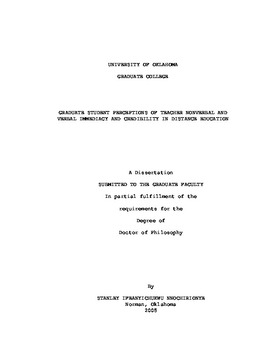| dc.contributor.advisor | Kramer, Eric, | en_US |
| dc.contributor.advisor | Johnson, Amy, | en_US |
| dc.contributor.author | Nnochirionye, Stanley Ifeanyichukwu. | en_US |
| dc.date.accessioned | 2013-08-16T12:19:48Z | |
| dc.date.available | 2013-08-16T12:19:48Z | |
| dc.date.issued | 2005 | en_US |
| dc.identifier.uri | https://hdl.handle.net/11244/867 | |
| dc.description.abstract | This study was designed to examine how student perceptions of teacher nonverbal and verbal immediacy relate to dimensions of credibility between I-TV face-to face and distance education classroom settings. The study further examined to what extent classroom setting was a moderator for the relationship between teacher immediacy and credibility. | en_US |
| dc.description.abstract | A total of 224 graduate students participated in this study which was conducted at East Central University, Ada, Oklahoma in the Spring of 2002. Of the 224 participants, 79 were on-campus (ONC) and 145 were off-campus (OFC) at seven selected distance education sites in Oklahoma. A total of nine I-TV instructors participated in this study, six of whom were females and three were males. | en_US |
| dc.description.abstract | This report reviews relevant literature, outlines the methodology utilized in this study, reports and discusses the findings, limitations of this study, and recommendations for future research. | en_US |
| dc.description.abstract | Specifically, the study compared the master's level graduate classes at East Central University, Ada, Oklahoma that are taught face-to-face on-campus and broadcast simultaneously to students at seven selected I-TV distance education classrooms via the Interactive Television (I-TV) instructional system. | en_US |
| dc.description.abstract | The following results were found: (1) The first hypothesis predicted that perceived teacher nonverbal immediacy will be significantly lower in the distance education classroom than in the face-to-face classroom was not supported even though the means were in the predicted direction. (2) The second hypothesis that predicted perceived teacher verbal immediacy would be lower in the distance I-TV classroom than in the face-to-face I-TV classroom was significant. Therefore, there was a stronger relationship between class format and verbal immediacy than perceived teacher nonverbal immediacy. (3) Hypotheses 2b and 2e, which predicted that perceived teacher competence and composure will be lower in the distance education I-TV classroom than in the face-to-face I-TV classroom was supported. However, hypotheses 2a, 2c and 2e, which predicted that perceived teacher sociability, extroversion and character respectively will be lower in the distance education I-TV classroom than in the face-to-face I-TV classroom were not significant, even though the means were in the predicted direction. (4) The result of the research question that asked "Was classroom setting a moderator for the relationship between immediacy and credibility in distance education?" indicated no support. All the correlations showed a positive relationship between teacher immediacy behaviors (nonverbal and verbal) and the five dimensions of credibility (competence, sociability, extroversion, composure, and character) and all were significant at the .01 alpha level, except the correlations between nonverbal immediacy and competence for the on-campus students, which was not significant (r = .181; p > .05). Thus, this pattern of results does not suggest that classroom setting is a moderator for the relationship between nonverbal and verbal immediacy and dimensions of credibility, as these variables were related positively in both classroom settings. | en_US |
| dc.format.extent | xvi, 208 leaves ; | en_US |
| dc.subject | Education, Technology of. | en_US |
| dc.subject | Education, Higher. | en_US |
| dc.subject | Mass Communications. | en_US |
| dc.subject | Television in higher education. | en_US |
| dc.subject | Distance education. | en_US |
| dc.title | Graduate student perceptions of teacher nonverbal and verbal immediacy and credibility in distance education. | en_US |
| dc.type | Thesis | en_US |
| dc.thesis.degree | Ph.D. | en_US |
| dc.thesis.degreeDiscipline | Department of Communication | en_US |
| dc.note | Chairs: Eric Kramer; Amy Johnson. | en_US |
| dc.note | Source: Dissertation Abstracts International, Volume: 66-02, Section: A, page: 0515. | en_US |
| ou.identifier | (UMI)AAI3163447 | en_US |
| ou.group | College of Arts and Sciences::Department of Communication | |
